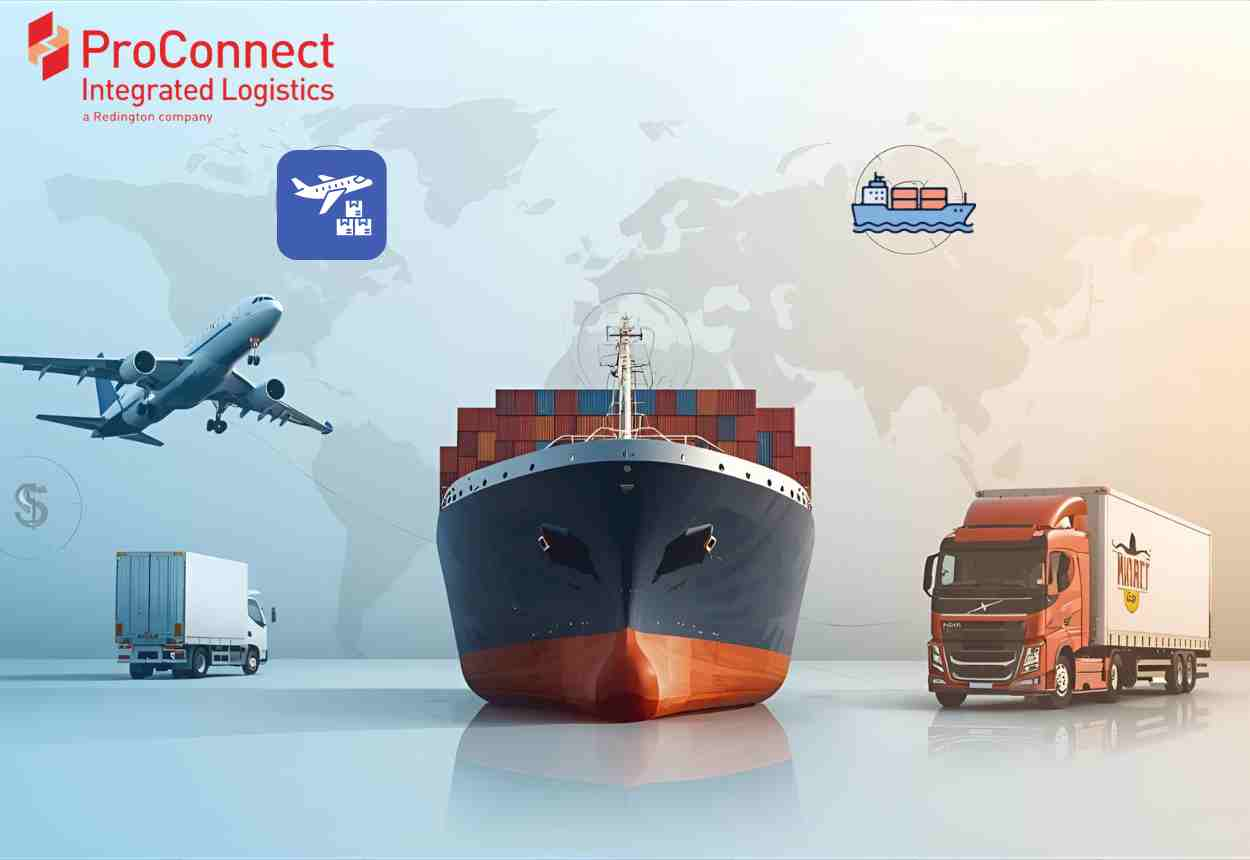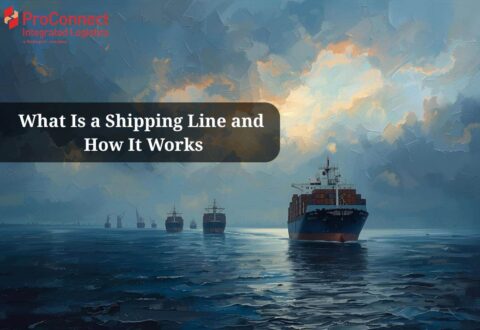In today’s fast-paced global trade environment, choosing the right freight forwarding method can make or break your supply chain. Whether you’re shipping bulk goods, time-sensitive products, or high-value cargo, the decision between sea freight vs air freight and road freight plays a crucial role in cost, speed, and efficiency.
In this guide, we’ll break down sea freight vs air freight, compare it with road transport, and help you choose the best shipping solution for your business.
What Is Freight Forwarding?
Freight forwarding is the process of coordinating and shipping goods from one destination to another using different modes of transport air, sea, or road. A freight forwarder like Pro Connect Logistics LLC acts as a logistics partner to ensure your cargo reaches safely, on time, and at the best cost possible.
Key functions of freight forwarding include:
- Cargo planning and documentation
- Customs clearance and compliance
- Transportation coordination
- Warehousing and distribution
- Cost optimization

Air Freight: Fast and Reliable Shipping
What is Air Freight?
Air freight is the transportation of goods via aircraft, ideal for time-sensitive and high-value shipments.
Advantages of Air Freight
- Speed: Fastest shipping option, ideal for urgent deliveries.
- Reliability: Fixed schedules and fewer delays.
- Security: Enhanced cargo protection during transit.
Disadvantages of Air Freight
- Higher costs compared to sea or road.
- Weight and size restrictions.
- Environmental impact is higher.
Best for:
- Electronics, medical supplies, fashion, automotive parts, and perishable goods.
Sea Freight: Cost-Effective for Bulk Shipments
What is Sea Freight?
Sea freight is the transportation of goods via cargo ships across oceans and seas. It’s the most common method for international trade.
Advantages of Sea Freight
- Cost-effective: Cheaper than air freight, especially for large shipments.
- High capacity: Perfect for bulk cargo and oversized goods.
- Eco-friendly: Lower carbon footprint than air transport.
Disadvantages of Sea Freight
- Slower transit time.
- Weather-related delays possible.
- More complex customs and port procedures.
Best for:
- Machinery, furniture, raw materials, heavy equipment, and bulk products.
Road Freight: Flexible and Convenient
What is Road Freight?
Road freight involves transporting goods by truck, ideal for domestic and cross-border deliveries.
Advantages of Road Freight
- Door-to-door service: No need for multiple handling points.
- Flexible routes: Easy to adjust schedules.
- Cost-efficient for short distances.
Disadvantages of Road Freight
- Slower for long-distance global trade.
- Subject to traffic or border delays.
- Capacity limitations.
Best for:
- Local and regional deliveries, e-commerce fulfillment, distribution to warehouses or retailers.
Sea Freight vs Air Freight and Road Freight: A Detailed Comparison
| Feature | Sea Freight | Air Freight | Road Freight |
|---|
| Cost | Low for bulk shipments | High — best for urgent cargo | Moderate for short to mid distances |
| Speed / Transit Time | Slow (2–6 weeks) | Fast (1–7 days) | Flexible (depends on distance) |
| Capacity | High — ideal for oversized & heavy goods | Limited — best for small/light cargo | Limited compared to sea but good for regional |
| Reliability | Moderate (weather & port delays possible) | Very high — fixed schedules | Moderate — affected by traffic & border delays |
| Environmental Impact | Lower CO₂ footprint | Higher emissions | Medium impact |
| Best Use Case | Bulk raw materials, machinery, heavy cargo | Electronics, medical supplies, urgent deliveries | Regional deliveries, last-mile distribution |
| Flexibility | Less flexible — fixed routes & schedules | Moderate — limited by airline schedules | Very flexible — door-to-door delivery |
| Geographic Reach | Global ports worldwide | Global airports network | Best for domestic and cross-border in regions |
| Customs Procedures | More complex | Moderate complexity | Simpler for domestic, more for cross-border |
| Ideal For | Importers/exporters, manufacturers | E-commerce, pharma, fashion, electronics | Distributors, retail, local delivery |
Choosing the Right Freight Method for Your Business
When deciding between Sea Freight vs Air Freight or road freight, consider the following factors:
- Delivery timeline – How fast do you need the shipment?
- Cargo size and weight – Heavy vs light, bulk vs small packages.
- Budget – Cost sensitivity and profit margins.
- Destination – Domestic vs international shipping.
- Sustainability – Environmental considerations.
For example:
- A fashion brand launching a new collection may prefer air freight for speed.
- A manufacturer importing raw materials may use sea freight to save costs.
- A local e-commerce business may rely on road freight for last-mile delivery.
Why Partner with Pro Connect Logistics LLC?
Choosing the right logistics partner can simplify your shipping process, reduce costs, and improve customer satisfaction.
Here’s how Pro Connect Logistics LLC supports your business:
- End-to-end freight forwarding solutions (air, sea & road)
- Global network with reliable shipping partners
- Transparent pricing and real-time tracking
- Expertise in customs clearance and documentation
- Warehousing, distribution, and last-mile support
- 560+ WCA Agents & 140+ trade lanes
Whether you’re a growing e-commerce company or a global importer/exporter, we make freight forwarding fast, cost-effective, and stress-free.
Conclusion
In the sea freight vs air freight or road freight debate, there’s no one-size-fits-all answer. The best shipping method depends on your cargo type, delivery urgency, and budget.
- Air freight for speed and reliability
- Sea freight for bulk and cost savings
- Road freight for flexibility and last-mile delivery
Need help optimizing your shipping strategy?
Contact Pro Connect Logistics today for a customized freight forwarding solution.
Frequently Asked Questions
What is the main difference between sea freight and air freight?
The main difference lies in speed and cost.
Air freight is faster, more reliable, and ideal for urgent or high-value shipments.
Sea freight is slower but more cost-effective for large or bulk shipments.
Businesses often choose air freight for time-sensitive deliveries and sea freight for cost savings on big consignments.
Which is cheaper sea freight or air freight?
Sea freight is generally much cheaper than air freight, especially for heavy or bulk cargo. Air freight rates are higher due to speed, fuel costs, and capacity limits. If budget is your priority, sea freight is usually the best option.
How long does sea freight and air freight take?
Air freight typically takes 1–7 days, depending on the distance and customs procedures.
Sea freight can take 2–6 weeks depending on the shipping route and port schedules.
For urgent deliveries, air freight is ideal. For planned bulk shipments, sea freight is more economical.
Can I combine sea freight and air freight for my shipments?
Yes, many companies use a hybrid shipping strategy, urgent products go by air, while the rest are shipped by sea. This approach helps businesses balance speed and cost effectively.
Which freight method is best for e-commerce businesses?
For e-commerce, air freight works best for fast-moving products that require quick delivery, while sea freight is great for stocking inventory in advance.
If the products are being delivered locally, road freight is often the most flexible and affordable.





 APP DOWNLOAD
APP DOWNLOAD